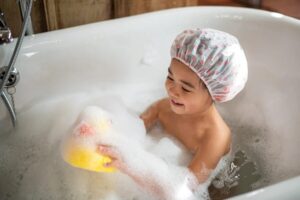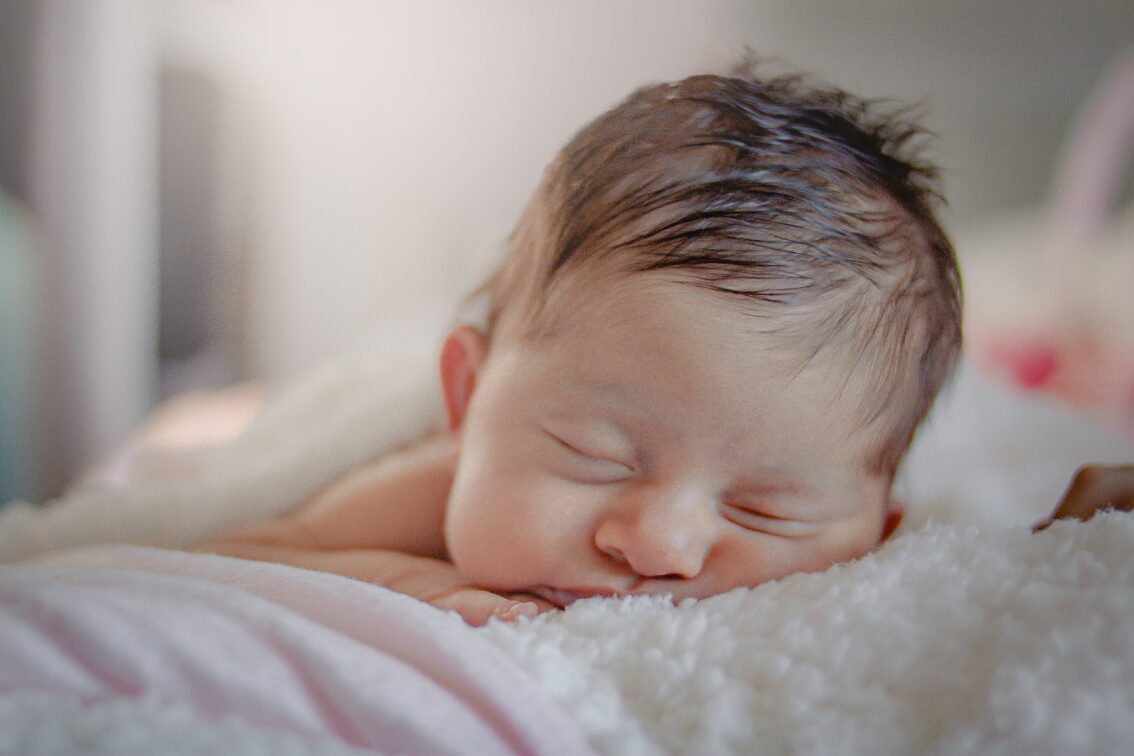*This post may contain affiliate links for which I earn commissions.*
When summer temperatures rise, getting a good night’s sleep can be tough—especially for infants and young children. Their bodies aren’t as adept at regulating temperature, which makes them more susceptible to heat-related sleep disruptions. As a parent, ensuring your little one sleeps comfortably in hot weather can feel like an uphill battle. But with the right strategies, you can create a cool, safe environment that promotes restful sleep even on the hottest nights.
In this guide, we’ll walk you through how to prevent heat-related sleep disruptions for infants and young children. From preparing their sleep environment to monitoring for signs of overheating, you’ll find everything you need to know to keep your child comfortable and safe all summer long.
What Are Heat-Related Sleep Disruptions?
Heat-related sleep disruptions occur when your child’s sleep is disturbed due to excessive heat. Unlike adults, infants and young children can’t regulate their body temperature as efficiently, making them more vulnerable to overheating. Symptoms like sweating, irritability, and restlessness are common signs that the heat is affecting their sleep.
Overheating during sleep can also lead to more serious conditions like heat exhaustion or even heatstroke, which is why it’s crucial to monitor your child’s temperature and adjust their environment as needed. By understanding how heat impacts sleep, you can take proactive steps to ensure your child remains cool and comfortable throughout the night.
How to Prepare a Cool Sleep Environment for Kids
Creating a cool, comfortable sleep environment is the first step in preventing heat-related sleep disruptions. Here’s how you can optimize your child’s room for summer sleep:
Temperature Control
Aim to keep the room temperature between 68-72°F (20-22°C). This is generally considered the optimal range for sleep, especially for infants and young children. Use fans or air conditioning to maintain a consistent temperature, and consider placing a thermometer in the room to monitor it.
- Fans: Position fans to circulate air without blowing directly on your child. An oscillating fan can be particularly effective, as it distributes air evenly throughout the room.
- Air Conditioning: If using an air conditioner, ensure that cool air isn’t blowing directly onto your child. Set the temperature to a comfortable level, ideally around 70°F, and use a thermostat to maintain it throughout the night.
See our reviews on top Air Conditioners
Bedding and Sleepwear
Choose light, breathable bedding and sleepwear to help regulate your child’s body temperature. Natural fabrics like cotton are excellent choices because they wick away moisture and allow air to circulate.
- Crib Sheets: Opt for lightweight cotton or muslin crib sheets, which are breathable and help prevent overheating.
- Sleepwear: Dress your child in light pajamas or a short-sleeved onesie. In extremely hot weather, a diaper alone may suffice.
- Sleep Sacks: If your child uses a sleep sack, choose a lightweight, breathable version. Avoid using heavy blankets or quilts, which can trap heat.
Room Darkening
Keeping the room cool during the day is also crucial. Close blinds or curtains to block out the sun and prevent the room from heating up. Consider using blackout curtains, which can significantly reduce the amount of heat entering the room.

Effective Cooling Strategies Before Bedtime
To set the stage for a cool, restful night, incorporate these cooling strategies into your child’s bedtime routine:
Lukewarm Bath
A lukewarm bath before bed can help lower your child’s body temperature, making it easier for them to fall asleep. Ensure the water is not too cold or too hot—lukewarm water is best as it gently cools the body without causing discomfort.
Hydration
Keeping your child hydrated is essential, especially in hot weather. Offer water throughout the day, and if your child is old enough, give them a small drink before bed. Proper hydration helps the body regulate temperature more effectively, reducing the risk of overheating during sleep.
Cooling Compresses
Using a cool, damp washcloth on your child’s forehead, wrists, or the back of their neck before bed can provide additional cooling. This simple technique can help lower their body temperature and make them more comfortable as they settle in for the night.

Best Technology and Tools to Keep Your Child’s Room Cool
Technology can be a big help when it comes to keeping your child’s room at a comfortable temperature. Here are some tools to consider:
Fans and Air Conditioners
Fans and air conditioners are the most common solutions, but it’s important to use them correctly:
- Fans: Position fans to circulate air around the room. If using an oscillating fan, place it where it can distribute air evenly without creating a strong draft directly on your child. For an extra cooling boost, try placing a bowl of ice in front of the fan.
- Air Conditioners: Set your air conditioner to maintain a consistent temperature. Avoid setting it too low, and ensure that the cool air isn’t blowing directly on your child.
Dreo Tower Fan for Bedroom
Experience powerful, quiet cooling with Dreo’s 36-inch compact tower fan. Offering customizable airflow, 90° oscillation, and safety features, this fan is perfect for any room. Enjoy refreshing comfort with easy-to-use modes and portable design. Ideal for bedroom, home and office.
Cooling Devices
There are several cooling products designed specifically for children:
- Cooling Mats and Pillows: These can be placed under your child’s sheet or used as a pillow to help keep them cool throughout the night. These products don’t require electricity and are a great way to provide gentle cooling.
- Portable Air Coolers: These are smaller and more energy-efficient than traditional air conditioners. They work by using water or ice to cool the air, making them an excellent option for smaller spaces.
Smart Thermostats
Smart thermostats allow you to monitor and control your child’s room temperature remotely:
- Automatic Adjustments: Program the thermostat to lower the temperature gradually as bedtime approaches and maintain it overnight.
- Remote Monitoring: Use the thermostat’s app to adjust the temperature without entering the room, ensuring your child isn’t disturbed during sleep.
How to Monitor for Signs of Overheating in Children
Even with all these precautions, it’s crucial to monitor your child for signs of overheating:
Common Signs of Overheating
- Sweating: If your child is sweating excessively during sleep, they may be too hot.
- Flushed Skin: Red or flushed skin can indicate overheating.
- Rapid Breathing or Heartbeat: A faster-than-usual breathing rate or heartbeat can be a sign of overheating.
- Irritability or Restlessness: Overheating often leads to discomfort, which can make your child irritable or restless during sleep.
- Heat Rash: Small red bumps, especially in skin folds, can be a sign of heat rash.
Immediate Steps to Take
If you notice any of these signs:
- Remove Layers: Remove extra clothing or bedding to help your child cool down.
- Move to a Cooler Spot: If possible, move your child to a cooler area of the house.
- Use a Cool Compress: Apply a cool, damp washcloth to help lower their body temperature.
- Offer Water: Ensure your child stays hydrated by offering a small amount of water.
- Adjust the Room Temperature: Lower the room temperature using a fan or air conditioner.
When to Seek Medical Help
In rare cases, overheating can lead to more serious conditions like heat exhaustion or heatstroke. Seek medical help if your child shows:
- High Fever: A body temperature above 100.4°F that doesn’t decrease with cooling measures.
- Extreme Lethargy or Unresponsiveness: If your child is unusually sleepy or unresponsive.
- Vomiting or Diarrhea: Persistent vomiting or diarrhea, which can lead to dehydration.
- Confusion or Dizziness: Signs of confusion or dizziness in older children may indicate heat exhaustion or heatstroke.
Final Tips: Keeping Your Child Cool and Safe All Summer
Ensuring your child sleeps comfortably in hot weather is a challenge, but with the right strategies, you can create a safe and cool environment. Remember to monitor your child for signs of overheating, and take action quickly if you notice any issues. With patience and a bit of preparation, your little one can sleep soundly, even on the hottest summer nights.
Additional Resources
For more tips and information on keeping your child cool during hot weather, check out these resources:
- AAP Safe Sleep Guidelines: Learn about the American Academy of Pediatrics’ recommendations for a safe sleep environment for infants.
- CDC Heat Safety for Children: Discover more about preventing heat-related illnesses in children.
- Cooling Products for Kids: Explore reviews of cooling products designed specifically for children, including sleepwear, bedding, and portable cooling devices.
🙋♀️ For more detailed reviews and tips on staying cool, be sure to explore other posts on our website. Check out our in-depth product reviews to find the best cooling solutions for your needs. Don’t forget to share your own experiences and tips in the comments below. Stay cool and beat the heat with Heatwave Hacks!


